When reading an analysis piece of a modern football match, the same themes of performance tend to dominate the text. Aspects such as passing, transitions, and formations are easy to pick up on and, therefore, the types of things that will always headline any tactical breakdown.
However, the truth is that those sorts of things only form half of the story as far as a team performance is concerned, with success or failure just as much down to what players do without the ball as well as the impact that they have with it. This was demonstrated clearly during Romania’s opening Euro 2024 match against Ukraine, where it was clear whilst watching that the former had considered carefully not only what they would do when the ball was in their grasp but how they would work together to facilitate the transitions and passing sequences that were so prominent in their play.
With that in mind, this tactical analysis will provide a breakdown of their performance to show why they emerged as comfortable winners in the end, but will put a special emphasis on their off-the-ball movement to show how they really had thought of everything and why that was crucial to them gaining such a dominant win.
Midfield control
From the outset of this match, Romania’s tactics largely revolved around their ability to control the middle of the field and never allow Ukraine to have an opportunity to either play through them or keep them pinned back. That was one of the reasons that they played in such an effective manner, both with and without the ball.

As far as their attacking play is concerned, accurate passing was critical to Romania’s ability to launch attacks and move the ball into promising areas of the field.
However, what will not have been picked up on is the role that those in the middle had in creating those passing routes, with the duo of Nicolae Stanciu and Răzvan Marin making so many clever runs that had a direct impact on Ukraine’s ability to defend against each attacking opportunity. In this situation, Stanciu has possession and is looking to find Marin in the space between them, knowing that the latter player will look to drop back here to get on the ball. The reason for that is that he wants to tempt the Ukrainian defenders into leaving their positions and, therefore, opening up spaces for the ball to then travel through.
On this occasion, the plan worked to perfection as Shakhtar Donetsk midfielder Heorhiy Sudakov followed him towards the ball and was, therefore, unable to prevent Romania from moving up the pitch and through the gap that he had left open. This shows how vital the midfielders were in facilitating Romania’s attacks and allowing them to exert their influence as soon as they had the ball.

Ukraine’s tactics in this game did not take long to decipher, with it clear that their aim was to send long balls towards Girona striker Artem Dovbyk and to try and utilise the aerial presence of the top scorer in La Liga last season. However, what will not have been as easily picked up on is that Romania did make these passes occur quicker than Ukraine might have liked them to as a result of their semi-committed pressing whenever they were out of possession, and that is another example of how player movement can sometimes go under the radar but was just critical to Romania’s win.
The player to highlight here is Marius Marin, who sat in the hole between the two lines in Romania’s 4-1-4-1 formation but was not simply limited to shielding the back line and was instead allowed to roam as he deemed necessary. As a result, whilst the rest of the shape remained rigid and robust, Marin flitted around the field and looked to have an impact wherever he could, and that included joining Denis Drăguș in the forward line and looking to take time away from Ukraine as they tried to plot a way through the block.
This can be seen here, with Marin moving towards the duo of Taras Stepanenko and Mykola Shaparenko and ensuring that they pass the ball quickly in order to limit the chance of it being lost too cheaply. The result of doing so was that many of their passes lacked the precision required and so led to potential attacks breaking down early on, and that was once again down to the subtleties of Romania’s play and their ability to have an impact on the game even when it appeared as though they were simply the beneficiaries of good fortune.
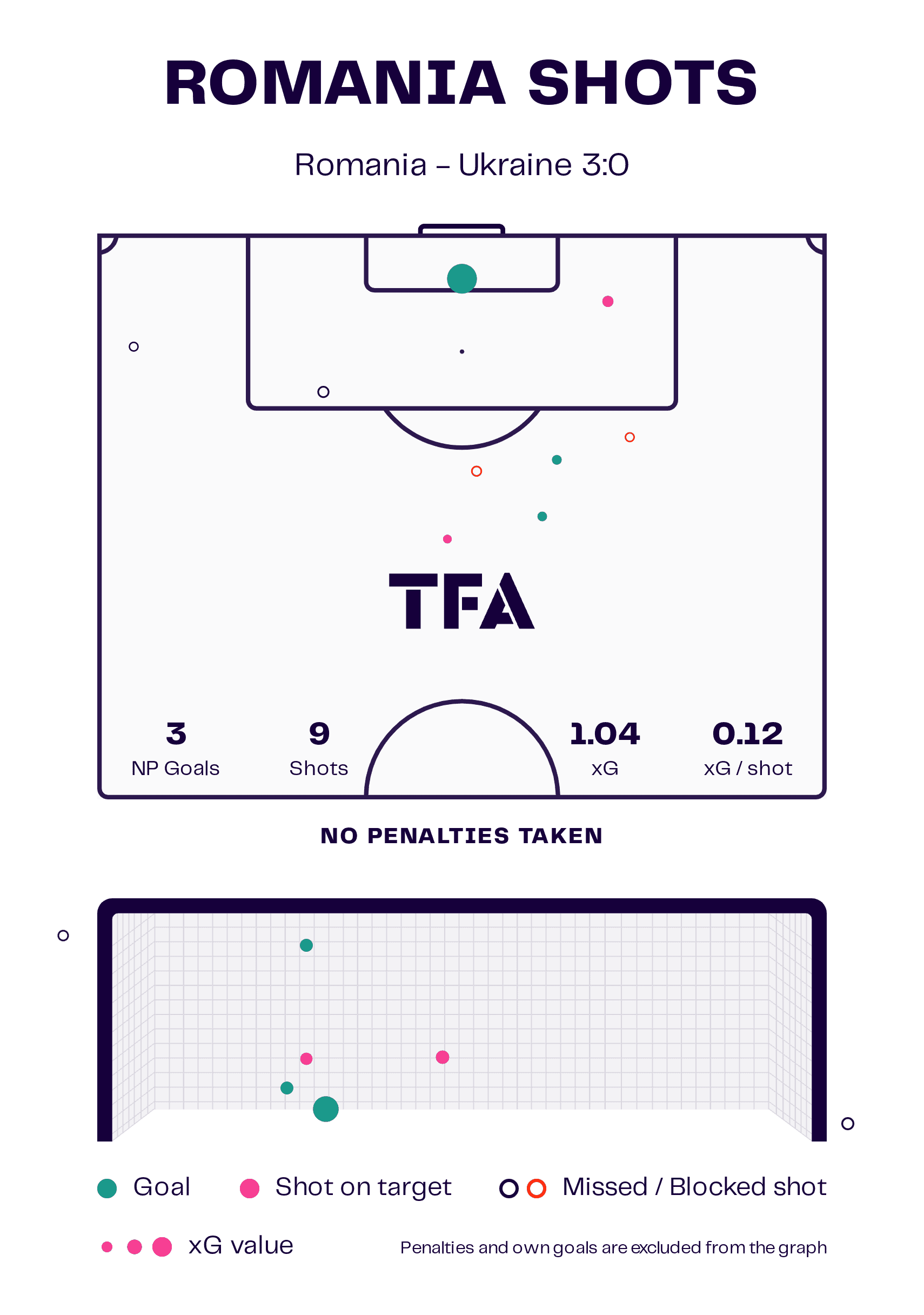
This is not to say that everything that the midfield did went under the radar, with this graphic highlighting the contributions that they made to the attacking threat through indicating the number of shots on goal that came from deeper areas.
However, it is simply to say that so much of what Romania did well came down to the ways in which the likes of Stanciu, Marin and Marin interacted with each other both with and without the ball and that it was this that made so much of what the wider team did well possible. There is certainly no doubt that Romania would have found it a lot harder to win the game without their midfielders working hard to create spaces, and that is what this analysis is looking to show.
Attacking threat
It was not only those in the central third who worked hard and went under the radar, though, with another who offered more than he would perhaps get credit for in some reports, being the aforementioned Drăguș. He might have only scored one goal on the night, but he was so influential around the field in other ways and really understood what was required of him at all times, meaning that he was another that the win would simply not have come about without.
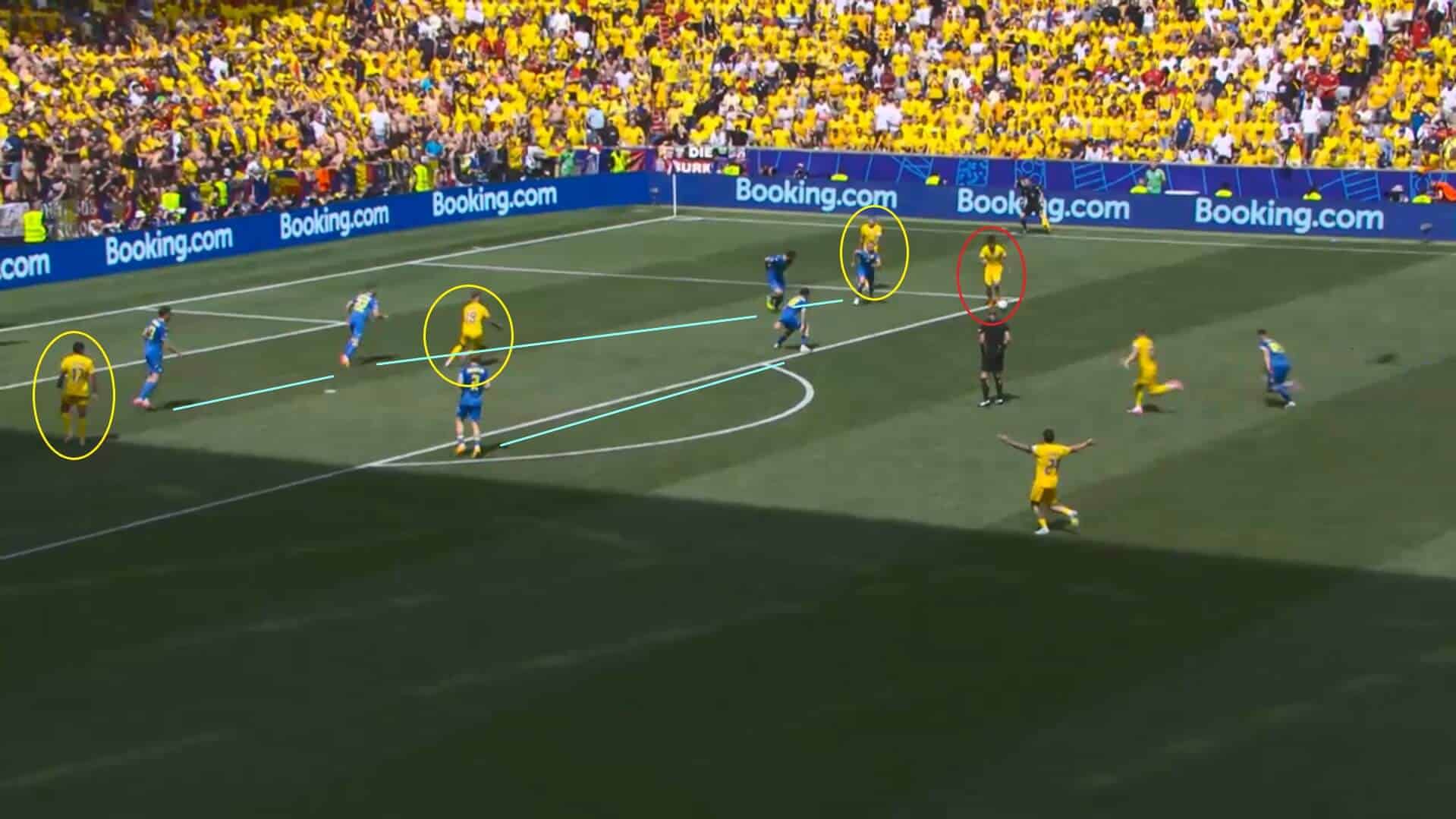
Much like Stanciu and Marin in the last section, Drăguș’ responsibilities when without the ball largely revolved around manipulating the Ukrainian back line into leaving gaps open ahead of them and forcing them to leave spaces open for his teammates to exploit, and that is shown here through him teaming up with winger Florinel Coman and right-back Andrei Rațiu to pin the defenders as far back as possible and to ensure that the other winger, Dennis Man, can cut inside and can get a shot away at goal.
This is perhaps the clearest example so far of players working hard off the ball for the good of their team. Drăguș constantly brought this to the table as the game went on, and it was one of the reasons that he was one of the most important players on the field.
A man might not have scored from this chance, but he had a number of opportunities to try his luck from further out, and the reason that he was able to do so was that Drăguș, in particular, kept creating the spaces for him to cut inside into. Therefore, that shows again how player movement, whilst not as easily noticeable, was critical to Romania’s win.

It was not only stretching the team vertically that Drăguș offered, though, and this graphic indicates how he had touches in so many different areas of the pitch and so brought the same mobile presence that Marius Marin did further back. It caused Ukraine so many problems inside their own third as the match went on, which prevented them from getting a hold of their opponents’ attack.
Therefore, this shows in no uncertain terms that Drăguș might not necessarily be a serial goalscorer but that his game is about so much more than simply putting the ball into the back of the net and that it is his all-round movement without it that Romania really depended on in this outing.
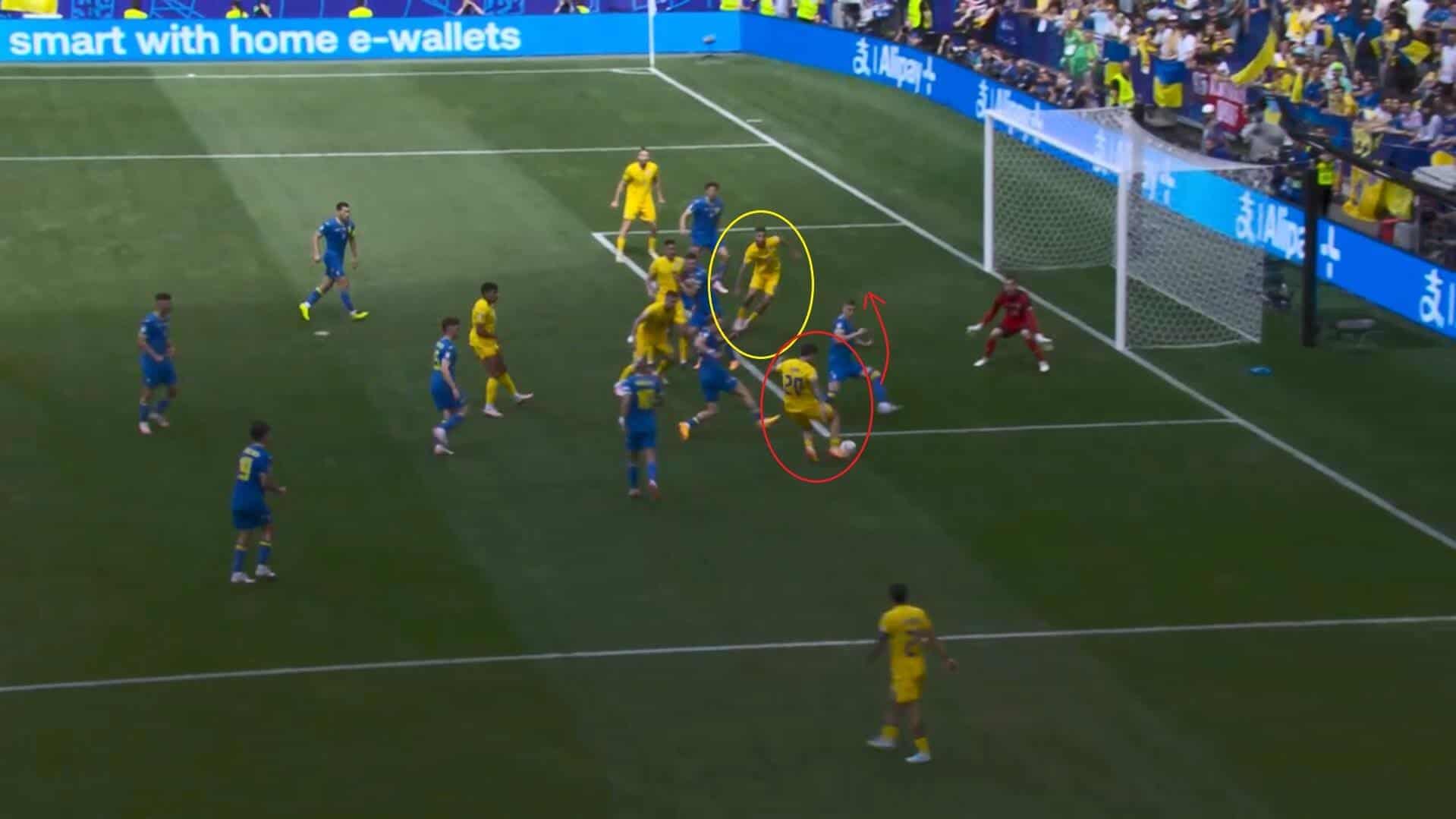
This is not to say that Drăguș’ goal threat should be doubted, with it already mentioned that he did score during the match. However, even that came about because of clever movement to create the opportunity, as the striker was in the midst of a duel with Arsenal’s Oleksandr Zinchenko here, and so had to throw him off in order to give himself the best possible chance of turning the ball into the back of the net.
To do that, he took a step backwards here before then jumping forwards, and, whilst that had the effect of keeping him onside when Man sent the ball in his direction, also ensured that he had given himself an extra second to connect with the ball and to ensure that he didn’t fluff his lines.
It should be mentioned that Romania were helped by Ukraine going to sleep as the quick corner was taken and so not being in a realistic position to prevent the shot from coming about, but there were once again subtle details to the way that Drăguș ensured that the goal would come about, and that highlights once again how he epitomised so much of the movement that allowed them to be so dominant.
Defensive play
When it came to the defensive side of things, it has already been mentioned that the midfield played a crucial role in forcing Ukraine to play the ball quicker than they would have liked. However, those in the back line also played their part in dictating the tempo of the match without making it seem as if they were doing so, and so they, too, deserve credit for their role in the win.
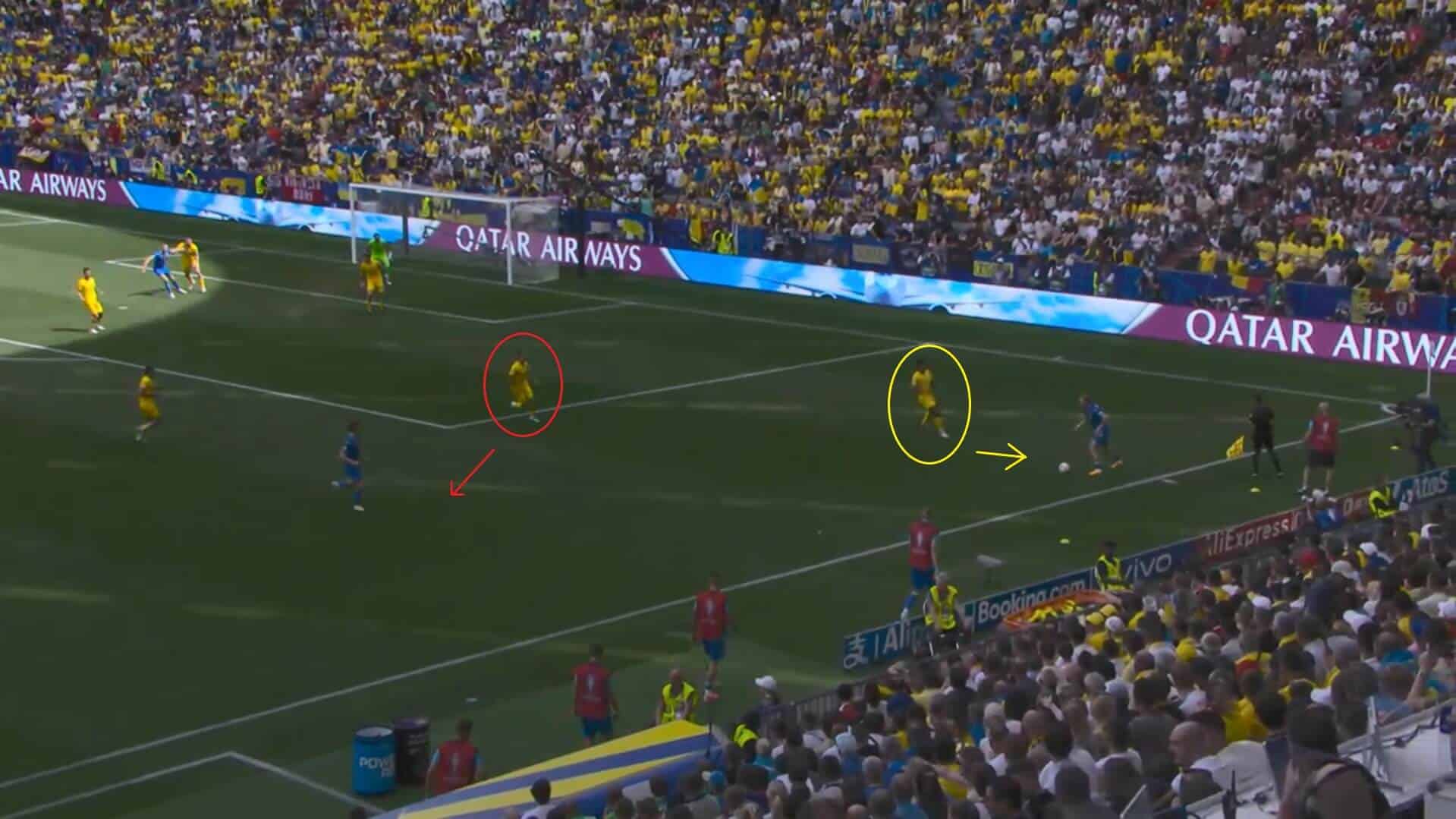
Ukraine’s desire to attack down the wings played into Romania’s hands as the match went on. The advantage of setting up in a 4-1-4-1 formation is that teams have a natural ability to double up as soon as the ball is moved towards either wing.
However, what was noticeable about how Romania implemented that was that they kept altering who led the defensive effort as the game went on, and so Ukraine never seemed to be aware of the pattern that was emerging. As a result, they never seemed to change their approach, so they kept looking to find a way into the middle from the wide areas and were continually thwarted.
The commitment shown by Romania indicated once again that they had belief in what they were being asked to do and also trust in each other to carry out their roles, with Shakhtar right-back Yukhym Konoplya being closed down by Coman, and so sending the ball towards Viktor Tsyhankov, who is then pressed by left-back Nicușor Bancu, and that unity once again highlights how everyone was working together to ensure that their game plan was as effective as possible.
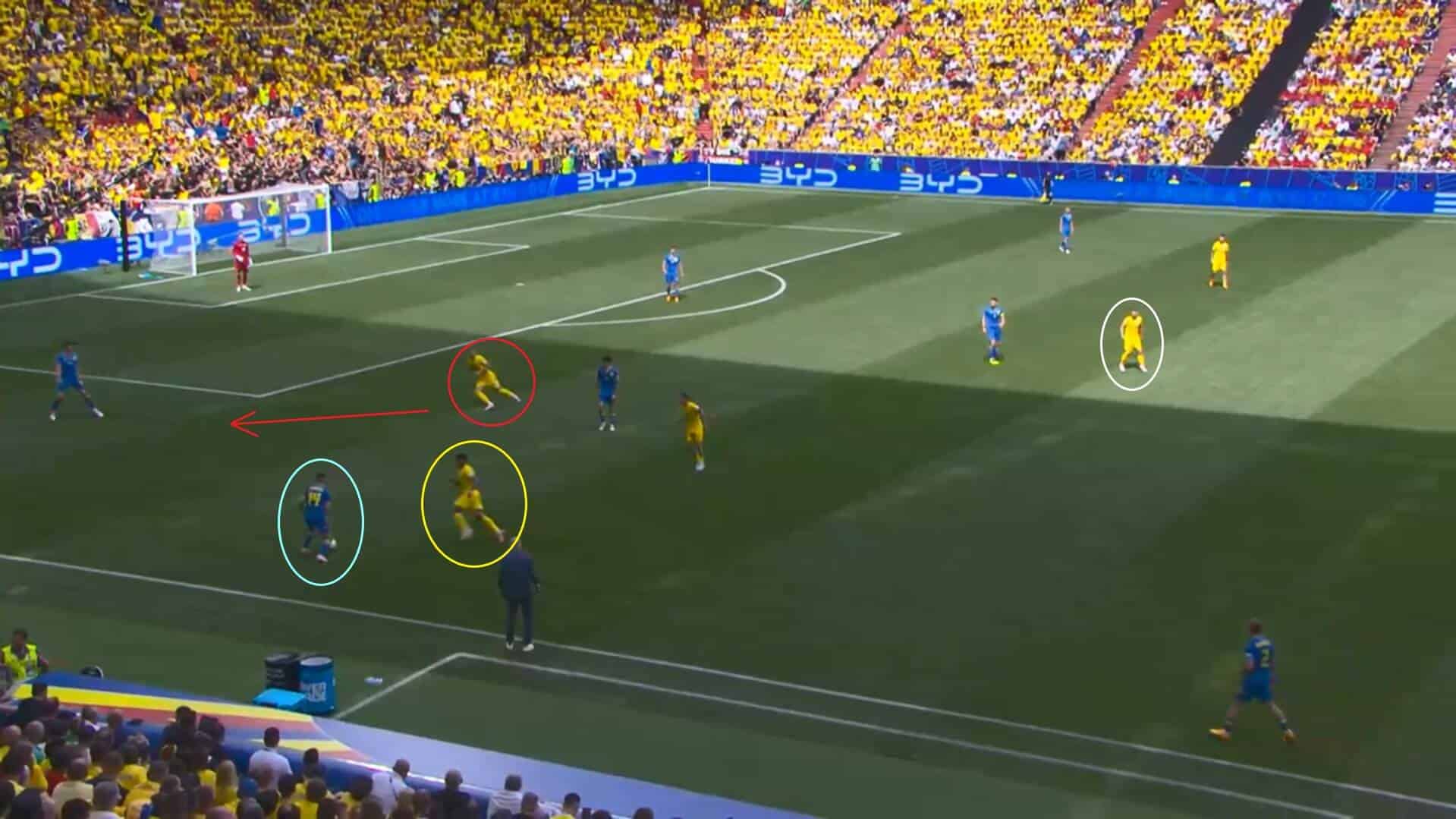
It was not only inside their own third that they looked to force the issue. There were moments at the other end when they were responsible for chances, and the best example of that came in the build-up to the opening goal of the match.
Many will rightly point towards the mistakes made firstly by Mykola Matviyenko and then by Real Madrid goalkeeper Andriy Lunin in allowing the goal to come about, but the goal actually started when Coman moved towards Shaparenko here and forced him to move the ball either behind him or sideways, and his options then became further limited when Drăguș moved to prevent the short pass behind him and so left him with no other option than to send the ball towards Matviyenko.
At this stage, it is clear that Romania have the advantage and know what will happen at each stage of the press, with Răzvan Marin already readying himself to move towards the ball as soon as it arrives at Matviyenko’s feet and to prevent him from finding a teammate. The fact that Marin then continues his press once the ball travels back to Lunin ultimately leads to the mistake that sees Man set up Stanciu to find the back of the net, and that once again highlights how it might appear as though this goal came about through Ukraine making mistakes, but actually it was Romania’s movement around the field and co-ordination that really set the wheels in motion.
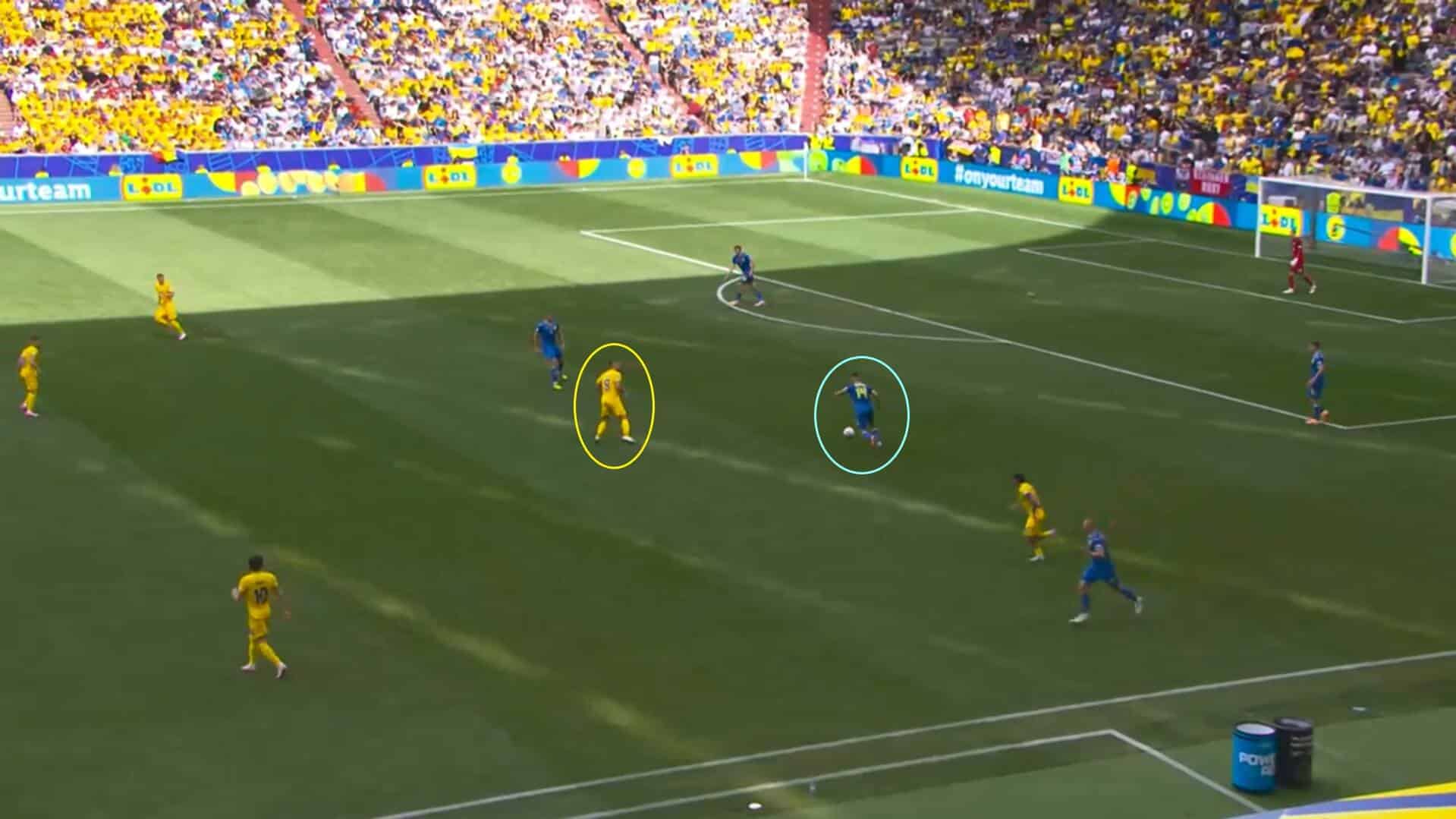
What was important for Romania, though, was knowing when to press and when to hold back, and it was certainly clear as the game entered its closing stages that they were happy with what they had already attained rather than pursuing more. As a result, situations like this were common, with Ukraine in possession and able to have the time on the ball that they had been looking for throughout the rest of the match, and that allows Sudakov to send the ball in the direction of former West Ham United winger Andriy Yarmolenko here in a diagonal manner.
From Ukraine’s point of view, their poor passing continued to let them down, but it is still clear that Romania was in charge of deciding how the match would go, with it being their decision to hold back and not get tight to the ball. This, therefore, again highlights how so much of what made them effective came down to what was not as easy for the eye to see, and that was paramount to their ultimate success.
Conclusion
In conclusion, this tactical analysis has looked in detail at Romania’s performance against Ukraine in their Euro 2024 opener, highlighting the reasons that they were able to take such a commanding win. The scout report has focused not so much on the way that they moved the ball around the field or the positions of each of their players but on the aspects of their play that were a lot more subtle, such as their ability to make clever runs off the ball that facilitated their transitions and the way that they controlled the flow of the game even when it appeared that they weren’t.
There have been a number of high-quality performances during the opening round of the Euro 2024 group stages, but Romania’s is certainly up there as one of the most complete and as perhaps one of the most surprising. However, there is no doubt that, when looking at how they prepared for this match and executed their game plan, they have arrived in Germany with a point to prove, and it will be well worth keeping an eye on them as the tournament goes on.





Comments